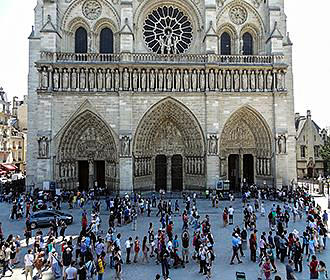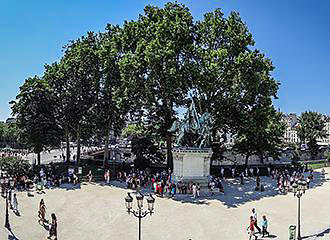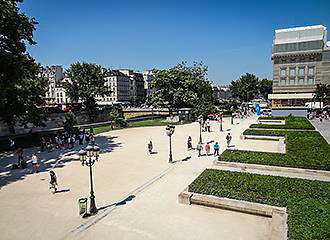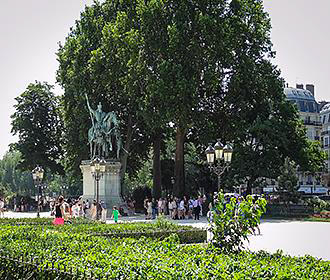Parvis Notre-Dame called Place Jean-Paul II in Paris
Originally just known as the Parvis Notre-Dame, this square was renamed in recent years and located at the front of the fabulous Paris Notre Dame Cathedral, this is where you will find the archaeological crypt, a statue of Charlemagne and more.
About Parvis Notre-Dame renamed as Place Jean-Paul II
To start with a parvis is known as either an enclosed area or a courtyard in front of a building, but this term is normally reserved for churches and cathedrals, and hence why, when you are standing looking at the western facade looking at the front entrance of Paris Notre Dame Cathedral, you will be standing in the square outside known as the Parvis Notre-Dame.
For many, many hundreds of years, it was accepted that the square in front of the fabulous Catholic cathedral was known only as the Parvis Notre-Dame and it was much smaller originally than what you will discover today.
Then during the remodelling of Paris in the 1800s by Baron Haussmann that the square was enlarged, and different features were put in place, plus other areas around this monument have been inaugurated with different names as time passed, such as the Square Jean XXIII after a former pope.
However, things changed in the September of 2006 when the Parvis Notre-Dame square in Paris was inaugurated by the Mayor of Paris, Bertrand Delanoe, with a full name of Parvis Notre-Dame - Place Jean-Paul II.
The square was renamed in honour of Pope Jean-Paul who had died in 2005, and a new traditional French plaque was unveiled at the ceremony, which shows the 4th Arrondissement, then its full name underneath, followed under this by the dates 1920 - 2005, again followed underneath by Pape (1978-2005).
And although there was a tribute paid to the former Pope during the ceremony and the square has remained the Parvis Notre-Dame - Jean-Paul II, there has been much controversy over this, with many disliking the idea immensely.
Yet there is more to this square in Paris than just the plaque.
Crypte Archeologique du Parvis Notre-Dame
We will not go into this particular aspect of the square in detail, as you can read far more about the Crypt of the Notre Dame Cathedral including how to visit this historical aspect and Paris museum.
But with its entrance in the Parvis Notre-Dame - Place Jean-Paul II, the archaeological crypt is located beneath the cathedral and is classified as the most important in all of Europe, which offers a unique look at urban and architectural aspects and the evolution of the Ile de la cite island where it is located.
Point Zero
Now if you look carefully at the ground within the Parvis Notre-Dame - Place Jean-Paul II you will find there is a medallion style plaque that has been embedded within the ground in front of the cathedral and this is classed as Point Zero.
Apparently it was put in place by the founder of the Michelin tyre business, Andre Michelin, and it is from this very plaque that all distances in France are measured, as this spot is classed as point zero, which is quite fitting considering the rich history of this island going back many centuries.
This particular point is classified as the very centre of Paris, and there is an inscription that reads Point Zero des Routes de France, and on some of the very old maps you would sometimes see a reference to the distance from where you are in France to the Paris Notre Dame cathedral and this point zero mark.
Statue of Charlemagne
Within the Parvis Notre-dame - Place Jean-Paul II square you will also be able to discover a large bronze statue of Charlemagne that sits on top of a stone base and depict him riding a horse with two gentlemen by his side.
Now, Charlemagne was King of the Franks and the first Holy Roman Emperor, yet he was also canonised as a saint back in the 1100s, and the inscription on this Paris statue reads Charlemagne et Ses Leudes. A Leude is defined as a noble companion or a guard of a chief, and therefore the inscription on the statue of Charlemagne would generally translate in English to Charlemagne and his Noble companions.
And even though this statue looks far older than it is, in fact, it was only designed and sculpted in 1886 by two brothers who were called Louis and Charles Rochet and portrays Charlemagne riding his horse accompanied by two gentlemen companions or guards.
Visiting the Parvis Notre-Dame - Place Jean-Paul II
As you have already gathered, this Paris square is situated in a very prominent position in front of the main entrance to Paris Notre Dame Cathedral and is located on the Ile de la Cite island in the 4th Arrondissement.
This also means that the nearest Metro station is called the Cite stop via line 4 located on the Ile de la Cite, however, if you are travelling on the RER, then the Saint Michel - Notre-Dame train station is the closest and is located on the left bank, which means you would then have to walk over the Petit Pont bridge in order to reach this area and it serves the RER B and RER C lines.
Yet right by the Parvis of Notre Dame Cathedral there is a bus stop for line 47 along with the Noctilien Night Bus Service via lines N15 and N22. There are also several other Paris buses that will get you within a short walk including lines 24, 67, 69, 75, 76 and 96.
Alternatively on the left bank by the Quai de Montebello there is a Batobus stop for the water bus that travels up and down the River Seine with stops at strategic tourist attractions such as the Eiffel Tower, and of course the historical Paris Notre Dame Cathedral.
Transport options
Paris Metro lines 1, 4, 11
Bus lines 21, 22, 24, 27
Bus line 38
Bus line 47
Bus lines 67, 69
Bus lines 70, 72, 74, 75, 76
Bus lines 81, 85
Bus line 96
Night bus lines N12, N13, N14, N15
Night bus lines N21, N22, N24
RER Train lines B, C
Water bus service



